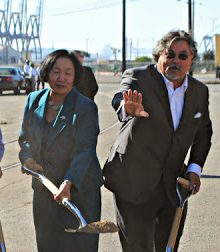Phil Tagami’s Uninspected Trench Harms Port, Could Cost Taxpayers Up to $5 Million
Oct 4, 2014
By Post Staff
Work on a portion of developer Phil Tagami’s Army Base project has been at a halt since March because the job was not built to Port of Oakland safety specifications and also utilized contaminated dirt that has to be dug up and replaced.
When the work will be resumed and who will have to pay for the errors has not yet been announced by city officials. The total cost could run as high as $5 million, according to Post sources.
The work in question was done by a contractor hired by the city’s agent, Master Developer Phil Tagami of CCIG, to dig a trench around the Army Base project.
The trench will contain underground electrical wiring that is placed within conduit and buried – what is referred to as the “utility corridor.” The Port of Oakland says the part of the trench that goes through its property is not deep enough because large vehicles and stacked containers could potentially damage or break the electrical lines.
According to sources, the Port of Oakland is also saying the trench should be covered by a concrete cap over the conduit.

Overall, the Army Base infrastructure project covers 160 acres and involves earthwork, grading, drainage, replacement of utilities and public roadway improvements. The total estimated cost is $270 million and will be completed on a four-and-a-half year timeline.
The city will not have to pay the costs of replacing the material in the trench, according to Assistant City Administrator Arturo Sanchez, speaking Tuesday at the meeting of the city’s Community and Economic Development (CED) committee.
“The material that went inappropriately into the trench – that cost will be borne by the contactor,” he said.
However, according to Post sources, the contractor who built the trench is not expected to pay for the additional work. Therefore, the name of contactor who will pay is still unspecified.
In addition, the Port of Oakland has come up with changes in its specifications for the trench, and these costs will have to be paid, said John Monetta, the city’s real estate manager at the Army Base Project.
According to Post sources, the port made its specifications clear from the beginning, and Tagami chose to ignore them.

Seeking answers to the costs to the city, Councilmember Lynette McElhaney said, “It is my understanding that the project doesn’t have any excess funding. We need to understand what the (change) is and what the fiscal impact is. “
Responding, Assistant City Administrator Sanchez said, “We believe we have a way to resolve it without it having a significant impact to the financial picture of the project.”
The total cost to replace the contaminated material and upgrade the trench is still not known, according to city staff

In addition, city staff is saying the problem of the contamination can be traced to aggregate left at the base by Urban Recycling Solutions, a company that is no longer in existence. But under questioning by Councilmember McElhaney, staff admitted that the material – crushed concrete and asphalt – was placed in the trench without being tested.
Tom Chasm, former manger of Urban Recycling, said the aggregate his company left at the base was tested and up to industry standards. There is no way to know if Urban Recycling was the source of the material used in the trench or if it was dumped by a different operator, according to Post sources.